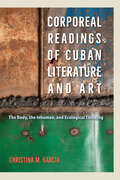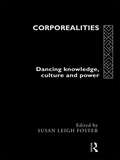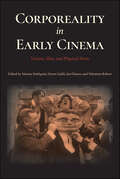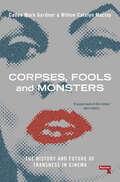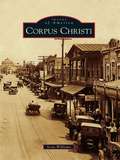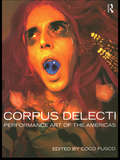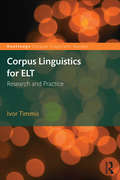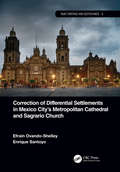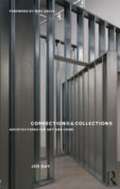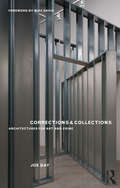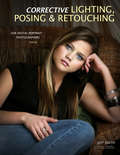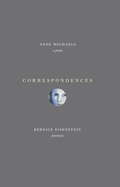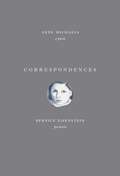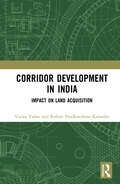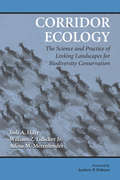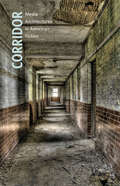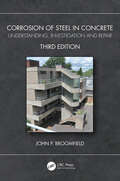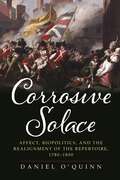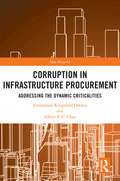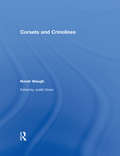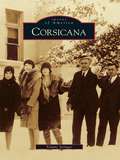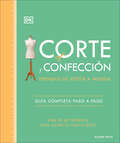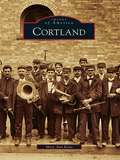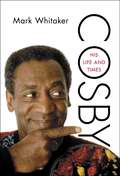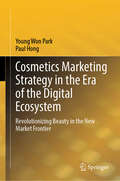- Table View
- List View
Corporeal Readings of Cuban Literature and Art: The Body, the Inhuman, and Ecological Thinking
by Christina M. GarcíaTracing corporeality and materiality across Cuban texts and images of the twentieth century This volume looks at Cuban literature and art that challenge traditional assumptions about the body. Examining how writers and artists have depicted racial, gender, and species differences throughout the past century, Christina García identifies historical continuities in the way they have emphasized the shared materiality of bodies. García shows how these works interact with ecologies of the human and nonhuman across diverse media, time periods, and ideologies. García examines corporeality in a variety of works, including the poetry of Nicolás Guillén and experimental writings of Severo Sarduy; transspecies drawings, paintings, and sculptures by Roberto Fabelo; Tomás Gutiérrez Alea’s popular queer film Fresa y chocolate; and contemporary narrative fictions by Ena Lucía Portela, Antonio José Ponte, and Ahmel Echevarría. Using the lenses of new materialism, critical race studies, critical animal studies, queer studies, and poststructuralism, García engages with Cuban cultural production at the intersection of diverse social issues. In this book, García explores how certain artistic practices focus on portraying ecological relationships instead of recognizable subjects or shared identity. Corporeal Readings of Cuban Literature and Art demonstrates that through their attention to the connections that different kinds of bodies share, Cuban creators have long undermined rules of classification and unification, reimagining community as shared vulnerability and difference. Publication of this work made possible by a Sustaining the Humanities through the American Rescue Plan grant from the National Endowment for the Humanities.
Corporealities: Dancing Knowledge, Culture and Power
by Susan Leigh FosterFirst published in 1995. Routledge is an imprint of Taylor & Francis, an informa company.
Corporeality in Early Cinema: Viscera, Skin, and Physical Form (Early Cinema in Review)
by Edited by Marina Dahlquist, Doron Galili, Jan Olsson and Valentine RobertCorporeality in Early Cinema inspires a heightened awareness of the ways in which early film culture, and screen praxes overall are inherently embodied. Contributors argue that on- and offscreen (and in affiliated media and technological constellations), the body consists of flesh and nerves and is not just an abstract spectator or statistical audience entity.Audience responses from arousal to disgust, from identification to detachment, offer us a means to understand what spectators have always taken away from their cinematic experience. Through theoretical approaches and case studies, scholars offer a variety of models for stimulating historical research on corporeality and cinema by exploring the matrix of screened bodies, machine-made scaffolding, and their connections to the physical bodies in front of the screen.
Corpses, Fools and Monsters: The History and Future of Transness in Cinema
by Willow Maclay Caden GardnerA radical history of transness in cinema, and an exploration of the political possibilities of its future.In the history of cinema, trans people are usually murdered, made into a joke, or viewed as threats to the normal order — relegated to a lost highway of corpses, fools, and monsters.In this book, trans film critics Caden Mark Gardner and Willow Catelyn Maclay take the reader on a drive down this lost highway, exploring the way that trans people and transness have evolved on-screen.Starting from the very earliest representations of transness in silent film, through to the multiplex-conquering Matrix franchise and on to the emergence of a true trans-authored cinema, Corpses, Fools and Monsters spans everything from musicals to body horror to avant garde experimental film to tell the story of the trans film image. In doing so, the authors investigate the wider history of trans representation — an exhilarating journey of compromise, recuperation, and potential liberation that they argue is only just the beginning.
Corpus Christi
by Scott WilliamsLatin for "Body of Christ," Corpus Christi is a popular vacation destination, military town, and thriving seaport. Legend has it that Spanish explorer Alonso Álvarez de Pineda discovered and named Corpus Christi Bay in 1519. Henry L. Kinney, a trader who arrived in the area around 1838, is credited with starting the trading post that eventually grew into one of Texas's largest cities and became home to one of the nation's busiest ports. This "Sparkling City by the Sea" balances growth and industry with an appreciation for the air, water, and wildlife that attract both sportsmen and environmentalists. Corpus Christi is a bilingual, bicultural community that embraces both its Mexican and American roots.
Corpus Delecti: Performance Art of the Americas
by Coco FuscoThe most comprehensive volume on performance art from the Americas to have appeared in English, Corpus Delecti is a unique collection of historical and critical studies of contemporary Latin performance. Drawing on live art from the 1960s to the present day, these fascinating essays explore the impact of Latin American politics, popular culture and syncretic religions on Latin performance.Including contributions by artists as well as scholars, Fusco's collection bridges the theory/practice divide and discusses a wide variety of genres. Among them are:* body art* carpa* vaudeville* staged political protest* tropicalist musical comedies* contemporary Venezuelan performance art* the Chicano Art movement* queer Latino performanceThe essays demonstrate how specific social and historical contexts have shaped Latin American performance. They also show how those factors have affected the choices artists make, and how their work draw upon and respond to their environment.
Corpus Linguistics for ELT: Research and Practice (Routledge Corpus Linguistics Guides)
by Ivor TimmisCorpus Linguistics for ELT provides a practical guide to undertaking ELT-related corpus research. Aimed at researchers, advanced undergraduate and postgraduate students of ELT and TESOL, and English language teachers, this volume: covers corpus research in the main areas of language study relevant to ELT: grammar, lexis, ESP, spoken grammar and discourse; presents a review of relevant corpus research in these areas, and discusses the implications of this research for ELT; suggests potential ELT-focused corpus research projects, and equips the reader with all the required tools and techniques to carry them out; deals with the growing area of learner corpora and direct classroom application of corpus material. Corpus Linguistics for ELT empowers and inspires readers to carry out their own ELT corpus research, and will allow them in turn to make a significant contribution to corpus-informed ELT pedagogy.
Correction of Differential Settlements in Mexico City's Metropolitan Cathedral and Sagrario Church (Built Heritage and Geotechnics)
by Efraín Ovando-Shelley Enrique SantoyoThis book describes the geotechnical aspects for correcting the geometry of Mexico City´s Metropolitan Cathedral and of the adjoining Sagrario Church. It describes the main aspects of geotechnical conditions in the city and of the most important hazards affecting these monuments. It discusses the analyses performed and the actions taken to achieve the corrections required. The book aims to provide non-specialists with a clear picture of the magnitude and importance of the project and of the achievements it fulfilled. It is expected that the book will also appeal to specialized geotechnical engineers that will be provided with references to follow up the project in depth. The book will contain a large number of illustrations and will be written so as to provide "down to earth" explanations of the basic theories applied and of the actual construction procedures The work will appeal to both students and professionals in the fields of Architecture and Civil Engineering. It will also interest specialized audiences of geotechnical engineers and conservation architects and it may also be of value to art historians.
Corrections and Collections: Architectures for Art and Crime
by Joe DayThe book explores and connects two massive expansions - how prisons and museums led the last great wave of American urban renewal and how civic space in the U.S was first cordoned into zones of cultural and societal transgression.
Corrections and Collections: Architectures for Art and Crime
by Joe DayAmerica holds more than two million inmates in its prisons and jails, and hosts more than two million daily visits to museums, figures which represent a ten-fold increase in the last twenty-five years. Corrections and Collections explores and connects these two massive expansions in our built environment. Author Joe Day shows how institutions of discipline and exhibition have replaced malls and office towers as the anchor tenants of U.S. cities. Prisons and museums, though diametrically opposed in terms of public engagement, class representation, and civic pride, are complementary structures, employing related spatial and visual tactics to secure and array problematic citizens or priceless treasures. Our recent demand for museums and prisons has encouraged architects to be innovative with their design, and experimental with their scale and distribution through our cities. Contemporary museums are the petri dishes of advanced architectural speculation; prisons remain the staging grounds for every new technology of constraint and oversight. Now that criminal and creative transgression are America’s defining civic priorities, Corrections and Collections will recalibrate your assumptions about art, architecture, and urban design.
Corrective Lighting, Posing & Retouching: For Digital Portrait Photographers
by Jeff SmithWith techniques for achieving a flawless portrait, this manual shows how to create stunning, professional images in any setting. Tips on how to delicately discuss and evaluate a subject’s appearance and his or her specific concerns combine with examples on how subtle changes in lighting and posing can flatter subjects#151;by slimming the waist and hips, enhancing the bust, narrowing the nose, reducing a double chin, and concealing baldness#151;helping portrait photographers sensitively downplay perceived flaws. Also illustrating how the latest in digital imaging technology can fix problems, this up-to-date resource shows how to digitally eliminate acne, whiten teeth, remove braces, and fix unnoticed clothing problems. Techniques for processing RAW files and for optimizing JPEG files for quick, but consistent, shooting are also included. With hundreds of new images, before-and-after sequences, and informative text, this is the ultimate reference for creating beautiful, flattering portraits.
Correspondences
by Anne Michaels Bernice EisensteinA rare and beautifully produced "accordion" book by renowned novelist and poet Anne Michaels and acclaimed artist and writer Bernice Eisenstein that will cause a stir for both its form and its content.Anne Michaels's resonant book-length poem--which unfolds on one side of the pages of this accordion book--ranges from the universal to the intimate, as she writes of historical figures for whom language was the closest thing to salvation; on the other side, we have Bernice Eisenstein's luminous portraits of and quotes from such twentieth-century writers and thinkers as Paul Celan, Nelly Sachs, W. G. Sebald, Anna Akhmatova, Primo Levi, and Albert Einstein. The poetry and portraits join together in a dialogue that can be read in any direction and any order, in a format that perfectly reflects the thematic interconnectedness of this collaboration: "an alphabet of spirits and spirit; an elegy of remembrance" (Eisenstein); "just as a conversation becomes the third side of the page . . . the moment one life becomes another" (Michaels).
Correspondences: A poem and portraits
by Anne Michaels Bernice EisensteinThis beautifully conceived book brings together the best-selling novelist and poet Anne Michaels and the acclaimed artist and writer Bernice Eisenstein in a unique, accordion-style format. Michaels' resonant book-length poem, a historical and personal elegy, unfolds on one side of the book's pages. On the other side, in unison with the poem, are Bernice Eisenstein's haunting portraits of the twentieth-century writers and thinkers Michaels' poem summons, for whom language was the closest thing to salvation: figures such as Paul Celan, Nelly Sachs, W. G. Sebald, Anna Akhmatova, Primo Levi, and Albert Einstein, each accompanied by quotations that illuminate the deeper connections among them. The poem is written to be read in sequence, as well as to join together with the portraits in a dialogue that perfectly reflects the thematic interconnectedness of this collaboration: 'an alphabet of spirits and spirit' (Eisenstein); 'the moment one life/becomes another' (Michaels). A stunning creation in both form and content, Correspondences is an unforgettable visual and poetic experience and a profound reflection on how the table of history is set by individuals.
Corridor Development in India: Impact on Land Acquisition
by Vinita Yadav Rohini Neelkanthrao KalambeThis book discusses the nuances of corridor development in India and its implications on land acquisition and displacement. It explores the complexities of land related conflicts and its socio-economic impacts on people’s lives. Examining the evolution of a few corridors of national importance like the Mumbai-Nagpur Expressway, Yamuna Expressway, Delhi-Mumbai Industrial Corridor, and Pune-Mumbai Expressway, the volume provides a comprehensive understanding of the dynamics of corridor development and regional growth. The book discusses how policies relating to land acquisition result in political, economic, legal and psychological hardships. The authors, using primary and secondary data, assess the socio-economic implications of land-acquisition on agriculture, employment, environment, demography, and land utilization along the regions touching these corridors. The work further discusses sustainable interventions in land acquisition practices to ensure equity of land and resources for vulnerable communities. The book will be useful for students and researchers of public policy, development studies, economics, urban and regional development studies and sociology. It will also be of interest to academicians, regional planners, and those working in the field of land development, resettlement and rehabilitation.
Corridor Ecology: The Science and Practice of Linking Landscapes for Biodiversity Conservation
by Adina Merenlender Jodi A. Hilty Andrew P. Dobson William Z. Lidicker Jr.Corridor Ecology presents guidelines that combine conservation science and practical experience for maintaining, enhancing, and creating connectivity between natural areas with an overarching goal of conserving biodiversity. It offers an objective, carefully interpreted review of the issues and is a one-of-a-kind resource for scientists, landscape architects, planners, land managers, decision-makers, and all those working to protect and restore landscapes and species diversity.
Corridor: Media Architectures in American Fiction
by Kate MarshallCorridor offers a series of conceptually provocative readings that illuminate a hidden and surprising relationship between architectural space and modern American fiction. By paying close attention to fictional descriptions of some of modernity&’s least remarkable structures, such as plumbing, ductwork, and airshafts, Kate Marshall discovers a rich network of connections between corridors and novels, one that also sheds new light on the nature of modern media.The corridor is the dominant organizational structure in modern architecture, yet its various functions are taken for granted, and it tends to disappear from view. But, as Marshall shows, even the most banal structures become strangely visible in the noisy communication systems of American fiction. By examining the link between modernist novels and corridors, Marshall demonstrates the ways architectural elements act as media. In a fresh look at the late naturalist fiction of the 1920s, &’30s, and &’40s, she leads the reader through the fetus-clogged sewers of Manhattan Transfer to the corpse-choked furnaces of Native Son and reveals how these invisible spaces have a fascinating history in organizing the structure of modern persons. Portraying media as not only objects but processes, Marshall develops a new idiom for Americanist literary criticism, one that explains how media studies can inform our understanding of modernist literature.
Corrosion of Steel in Concrete: Understanding, Investigation and Repair
by John P. BroomfieldCorrosion of Steel in Concrete: Understanding, Investigation and Repair is a guide for designing, constructing and maintaining reinforced concrete structures, such as buildings and bridges which are subject to reinforcement corrosion. It presents the basics of theory and practice in steel corrosion in concrete and reviews the latest research and developments, such as progress on measuring the corrosion threshold for chloride-induced corrosion. This third edition compares the currently proliferating major national and international standards and guidance documents. New developments are considered, such as hybrid anodes for electrochemical treatment and the latest research and developments in assessment, such as the use of ground penetrating radar to measure the chloride content of the concrete cover. It overhauls coverage of electrochemical repair and rehabilitation techniques and outlines recent innovations in structural repair and construction and investigates their implications for durability. The book is ideal for practitioners and graduate students in structural engineering and concrete technology.
Corrosive Solace: Affect, Biopolitics, and the Realignment of the Repertoire, 1780-1800
by Daniel O'QuinnIn Corrosive Solace, Daniel O’Quinn argues that the loss of the American colonies instantiated a complex reorganization in sociability and politics in the British metropole that has had long-lasting effects on British national and imperial culture, which can be seen and analyzed within its performative repertoire. He examines how the analysis of feeling or affect can be deployed to address the inchoate causal relation between historical events and their mediation. In this sense, Corrosive Solace’s goals are twofold: first, to outline the methodologies necessary for dealing with the affective recognition of historical crisis; and second, to make the historically familiar strange again, and thus make visible key avenues for discussion that have remained dormant. Both of these objectives turn on recognition: How do we theorize the implicit affective recognition of crisis in a distant historical moment? And how do we recognize what we, in our present moment, cannot discern?Corrosive Solace addresses this complex cultural reorientation by attending less to “new” cultural products than to the theoretical and historical problems posed by looking at the transformation of “old” plays and modes of performance. These “old” plays—Shakespeare, post-Restoration comedy and she-tragedy—were a vital plank of the cultural patrimony, so much of O’Quinn’s analysis lies in how tradition was recovered and redirected to meet urgent social and political needs. Across the arc of Corrosive Solace, he tracks how the loss of the American War forced Britons to refashion the repertoire of cultural signs and social dispositions that had subtended its first empire in the Atlantic world in a way more suited to its emergent empire in South Asia.
Corruption in Infrastructure Procurement: Addressing the Dynamic Criticalities (Spon Research)
by Albert P.C. Chan Emmanuel Kingsford OwusuThis book presents an extensive study on the extant constructs of corruption in infrastructure-related projects and aims to contribute to the determination and elimination of its incidence and prevalence in infrastructure projects. The book conducts a comprehensive examination of the various determining factors of corruption that negatively affect the procurement process and, in the end, result in cost and time overruns. The authors present an in-depth understanding of how the identified determining factors of corruption can be addressed. Thus, it is intended to broaden the reader's knowledge of the causes, risk indicators, and different forms of corrupt practices in the procurement process of infrastructure works, before explaining how they affect its stages and activities A dynamic model is developed to demonstrate how to tackle the overall impact of corruption within the procurement process and, at the same time, increase the effectiveness of the extant anti-corruption measures. In short, this book demonstrates that the fight against corruption in the procurement process is strategically feasible and must continue. This book is essential reading for academics, researchers, professionals and stakeholders in the procurement of infrastructure projects and civil works, as well as those with an interest in corruption, construction management and construction project management.
Corsets and Crinolines
by Norah Waugh Judith DolanIn this classic book, Norah Waugh explores the changing shapes of women’s dress from the 1500s to the 1920s. Simple laced bodices became corsets of cane, whalebone and steel, while padding at shoulders and hips gave way to the structures of farthingales, hoops and bustles. Corsets and Crinolines explains the cyclical nature of these fashions, and how waists and skirts changed shape and size through three distinct eras: The 1500s to 1670—farthingales and whaleboned bodies. 1670 to 1800—Stays and hooped petticoats. 1800 to 1925—corsets, crinolines and bustles. Each section describes how these garments originated, how they became popular and how they emerged as central to the fashions of the time. Extracts from diaries, journals, poems and newspapers, as well as over 100 illustrations, demonstrate the variety of these ubiquitous items of clothing throughout modern history. Corsets and Crinolines also contains a wealth of practical notes and resources for today’s costume makers and designers, including: Scaleable patterns for the construction of 25 different bustles, crinolines, corsets, corselets, stays, pocket hoops, hooped petticoats and bodices. Detailed appendices on the manufacture of corsets and crinolines, including farthingales, supports and hooped petticoats. A list of further reading, including costume histories; textile and weaving histories; reconstruction of period clothing; contemporary application of foundational garments; and a list of museums and institutions with period clothing collections, for first-hand study. A glossary of terms and materials.
Corsicana
by Dr Tommy StringerThe first Texas legislature created Navarro County in 1846 and named it in honor of Texas patriot Jose Antonio Navarro. When asked to name the new seat of government, Navarro replied, "Call it Corsicana for the island of Corsica, the birthplace of my father." From its beginnings in 1848, Corsicana's history has been marked by Texas icons such as cotton, cattle, and chili. The town's history took a dramatic turn when drillers looking for water struck oil instead in 1894. By the end of the decade, more than 500 wells dotted the landscape, marking the first commercial oil field in Texas and launching the industry that has become synonymous with the Lone Star State. Oil, business enterprises, and politics are important parts of Corsicana's legacy, but much of its history is found in the everyday events that make up the fabric of a community. Local history is filled with stories of people who overcame obstacles to fulfill the American Dream.
Corte y confección (The Tailoring Book): Prendas de vestir a medida
by Alison SmithTodo lo que necesitas saber para diseñar, crear y personalizar tu ropa Aprende las técnicas y los procesos básicos de confección y ensamblaje de prendas, perfecciona tu técnica y gana confianza y eficacia hasta dominar técnicas de alta costura más avanzadas como el montaje de mangas y cuellos, el entretelado o el forrado.Tanto si quieres alterar una prenda vintage como si deseas crear tu propia ropa desde cero, este libro de corte y confección es el manual de referencia que todos los aficionados de la moda necesitan:-Con más de 80 técnicas que pueden aplicarse tanto a la ropa femenina como a la masculina, desde la elección de patrones y tejidos hasta el ajuste y la confección.-Instrucciones paso a paso, ilustraciones y fotografías en gran formato y patrones descargables.-Consejos prácticos sobre medición, corte, alteración y acabado.-Información sobre el material y los útiles de costura necesarios para crear patrones, cortar telas y coser diferentes prendas y diferentes tejidos, a mano y a máquina.-10 proyectos para crear camisas, chaquetas, abrigos y pantalones a medida.Descubre los secretos de la confección de moda de la mano de una de las mayores expertas en sastrería del mundo y empieza a crear, renovar o reinventar prendas según tu estilo.---------------------------------------------Whether you want to alter a vintage jacket or create a full-tailored suit, this tailoring reference guide has everything you need to produce elegant, bespoke garments that last a lifetime.With over 80 step-by-step techniques on measuring, cutting, altering, and finishing, this is the only book you will need to create and alter a tailored garment.Alison Smith MBE is one of the world's leading tailoring experts, and in her new book, she reveals trade secrets and all the practical know-how necessary to master this heritage craft. The Tailoring Book is the latest title in Smith's best-selling sewing series. It covers everything from choosing patterns and fabrics to fitting and construction, including techniques that can be applied to both womens- and menswear.With this book, you can learn how to:-Tailor garments by selecting the right tools to create a toile and picking the perfect hand stitch.-Follow 10 detailed garment projects to create shirts, jackets, coats, and trousers-Master the techniques of tailoring with step-by-step instructions and downloadable patterns that guide you through every part of the processThis book includes key equipment and techniques, garment projects with clear step-by-step processes and downloadable patterns, and tips on repairs and alterations. It takes the reader from the basics through to couture techniques.
Cortland
by Mary Ann KaneWhen Cortland was incorporated as a village in 1853, its population was mainly transplanted New Englanders and Irish immigrants, and it encompassed territory 1 mile from east to west. By 1871, two rail lines crossed the village, and their cargos of coal encouraged the development of industries, particularly carriages and sleighs. The 1890s brought Cortland's first urban renewal with industrialists replacing wooden mansions with ones of brick, stone, and Queen Anne designs. The 20th century opened with full employment in industries that not only served the country but also the world. This encouraged Italians, Ukrainians, and Lebanese to settle in Cortland and share their heritage. Photographs from the archives of the Cortland County Historical Society illustrate how life was lived in Cortland before the 21st century.
Cosby: His Life and Times
by Mark WhitakerThe first major biography of an American icon, comedian Bill Cosby. Based on extensive research and in-depth interviews with Cosby and more than sixty of his closest friends and associates, it is a frank, fun and fascinating account of his life and historic legacy.Far from the gentle worlds of his routines or TV shows, Cosby grew up in a Philadelphia housing project, the son of an alcoholic, largely absent father and a loving but overworked mother. With novelistic detail, award winning journalist Mark Whitaker tells the story of how, after dropping out of high school, Cosby turned his life around by joining the Navy, talking his way into college, and seizing his first breaks as a stand-up comedian. Published on the 30th anniversary of The Cosby Show, the book reveals the behind-the-scenes story of that groundbreaking sitcom as well as Cosby's bestselling albums, breakout role on I Spy, and pioneering place in children's TV. But it also deals with professional setbacks and personal dramas, from an affair that sparked public scandal to the murder of his only son, and the private influence of his wife of fifty years, Camille Cosby. Whitaker explores the roots of Cosby's controversial stands on race, as well as "the Cosby effect" that helped pave the way for a black president. For any fan of Bill Cosby's work, and any student of American television, comedy, or social history, Cosby: His Life and Times is an essential read.
Cosmetics Marketing Strategy in the Era of the Digital Ecosystem: Revolutionizing Beauty in the New Market Frontier
by Young Won Park Paul HongThis book explores how cosmetics firms have made the transition to technology-enabled beauty companies to meet changing customer demands. For this purpose, the contexts of cosmetics industry growth and digital marketing strategy in the post-pandemic world are presented here. The digital marketing strategies of Japanese and Korean firms are shown, along with new business models and future prospects in cosmetics industries. In the post-pandemic world, the growing middle class will set priorities for beauty–hygienic goals, nutritional choices, and healthcare development needs. The growth rates of Asian economies were slowed during the COVID-19 pandemic, yet their growth opportunities were not constrained. Diverse industries—the cosmetics industry in particular—have addressed the needs of these growing segments in Asia. In keeping up with the leading business trends, cosmetics firms also have leveraged big data and built their brand partnerships across industries, applying the Internet of Things (IoT) and artificial intelligence for their product and process development. The vast amounts of big data gathered through IoT devices are now being used to improve entire value chain operations, creating a digital thread through the global value chain. These data are increasingly used to create new services and develop a business model for global firms. As of 2021, four of the top ten global cosmetics firms are from the USA (Estée Lauder, Proctor & Gamble, Coty, and Johnson & Johnson), three are from Europe (L’Oréal, Unilever, and Beiersdorf), two from Japan (Shiseido and Kao), and one from Korea (Amore Pacific). The USA and European firms still maintain their competitive advantage in the cosmetics industry. Global cosmetics market share by region shows that North Asia is the largest (35%), followed by North America (26%) and Latin America (7%), Europe (22%), and Africa and other regions (10%). With the rapid increase of the middle class in the Asia region, more sales are expected there than anywhere else. In this dynamic market environment, a real challenge for the cosmetics industry is how to develop and put into practice its own unique business model.
